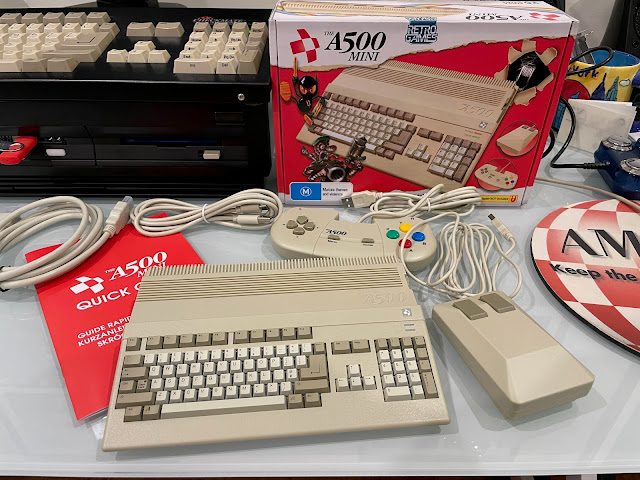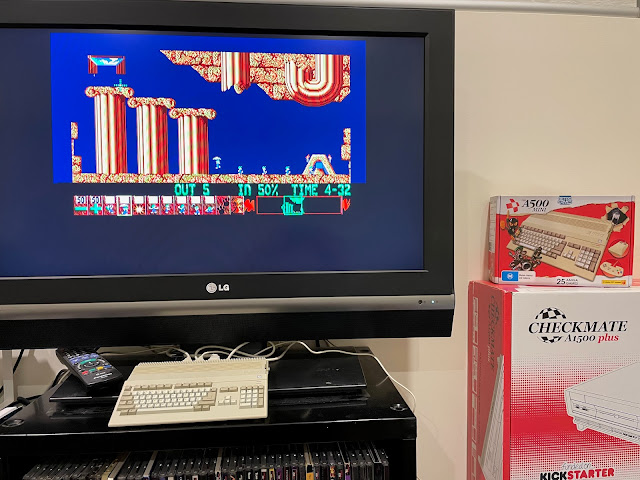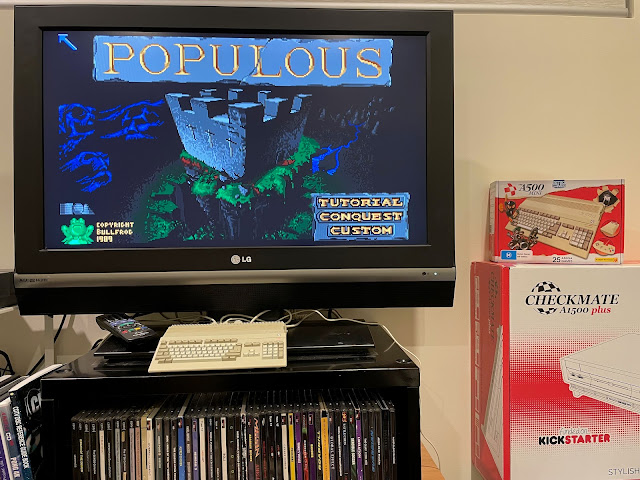The A500 Mini is finally released in 2022, and I received mine a few days ago. Let's take a look!
As I am an owner of many Classic Amiga systems, FPGA solutions like MIST/Minimig, Emulation solutions (Raspberry Pi, FS-UAE, WinUAE, Amiberry) and NG Amiga hardware, lets clear the air about this A500 Mini system from the beginning. What it is and what it isn't, and who I think it is meant for.
What the A500 Mini is:
- A small, attractive, easy to setup and use emulation of 25 pre-packaged WHDLoad Amiga 500 games, that hooks directly into your modern HDMI TV.
- Easy to use interface to select and launch pre-packaged games, with save game support for each making it easy to save progress for games that never did support such functionality!
- An adequately performing emulation of a Workbench 1.3 era 1MB Amiga 500 gaming system, with a limited amount of Amiga 1200 AGA game support.
- Designed to add WHDLoad packages via USB stick to play additional games not included with the system. (must be in .lha format)
What the A500 Mini isn't:
- A fully functional Amiga system, upgradeable to use RTG, networking, sound cards, full AmigaOS 1.3/2.0/3.1/3.2/3.9 workbench and application functionality.
- Set up to allow the use of the most commonly distributed Amiga ADF floppy images and HDF hard disk images. Only WHDLoad packages are officially supported and ADF/HDF are not. I know the A500 Mini can be modified to use ADF files, but it is apparently not setup to allow ADF support for legal reasons.
- A replacement for real Amiga hardware, for people who already have one or more Amiga systems. It will never have the same functionality and expandability.
- An emulation of an Amiga 500/Amiga 1200 demoscene system. It's performance is equivalent to a Raspberry Pi 3, which does not allow for running all Amiga demos as they were on the original hardware. (admittedly some do work in my testing - but many run badly or glitching)
- Equivalent performance for Raspberry Pi 4/Pi400 systems running similar Amiberry emulations with AmiKit XE or PiMiga distributions running on Linux. It just isn't as fast. The Pi 4/Pi 400 is a better Amiga emulation system, runs much faster, is cheaper, and has more out of the box features, but it doesn't have the cool Amiga 500 casing. (how long before someone transplants a pi4/pi400 into the A500 Mini case I wonder?)
Who the A500 Mini is meant for:
- Nostalgic former Amiga owners, who don't have a Classic Amiga anymore.
- Former Amiga owners who only used the system for playing games, and have no interest in what the Amiga can do beyond gaming.
- Former Amiga owners who don't want to be bothered with setting up emulation or Classic Amiga hardware, and just want a quick plug and play nostalgic Amiga gaming experience.
With all that out of the way, hopefully I have covered the majority of criticism levelled at this machine and you can make an informed choice.
Knowing the target market for the A500 Mini is not really me, I bought this primarily to see what it was like, and especially to steal the cool USB infrared mouse remake to use on my real Amiga that has a USB converter on the mouse port!
The packaging is very nice, and similar to other similar Mini game systems like the SNES, NES, Playstation, Neo Geo Mini, etc.
For me, some of the games are ones I would have included in my favourite list - Pinball Dreams, Stunt Car Racer, Speedball 2, Super cars II, Worms Directors Cut (actually an AGA game), and The Chaos Engine.
Glaring Classic Amiga game omissions in my view are classics like Lemmings, Populous, Shadow of the Beast, Gods, Lotus 2, Cannon Fodder, Agony, R-Type, Battle Squadron, Hired Guns, Xenon 2, Rainbow Islands, Indy Heat, Nitro, and many others.
But you can't please everyone!
Opening the box, the very impressive A500 Mini system case it displayed, and the attention to detail is very impressive.
Also, included in the box is a Gamepad and USB Amiga mouse remake, infrared rather than with the traditional mouse ball underneath. The mouse is a big part of why I got this system!
If your keyboard has a USB hub in it, that is the ideal situation - a Raspberry Pi USB keyboard is great for this and is small enough to carry around with the A500 Mini.
The underside looks nice, with rubber feet and a A500 Mini sticker and serial number. The cutout for the A500 Zorro expansion indent on the left side and expansion port is not included in the bottom, but I guess that is nitpicking. Most people won't even notice.
Here is a comparison of a real Amiga 500, and the new A500 Mini to give you a better sense of the tiny size of the A500 Mini:
I connected the A500 Mini to my LG Plasma TV, that I bought from Cash converters for $10 recently to use with my CD32 and CDTV, as it has the required AV and HDMI ports. Seriously, $10. Works perfectly.
Pinball Dreams is first up - and I note you can bring up a virtual keyboard during the emulation to input F1, F2 etc to select the tables in the game, without needing an external physical keyboard.
I then tried Supercars 2 and Speedball 2, two more of my favourite games of the included set of games on the A500 Mini:
As covered in the manual included with the A500 Mini, it is also possible to run other Amiga games that are packaged using WHDLoad and presented as lha files on a USB stick you connect to the A500 Mini:
I put the USB stick in my Mac Pro, and downloaded the required A500 WHDLoad package, extracted to the USB stick as the manual explains:
Having prepared the USB Stick, I downloaded a A500 Mini WHDLoad Games package from the internet.
The package has a large selection of games (which I already own) that are sorted alphabetically, and WHDLoad packaged in lha form, ready to use on a USB stick with the A500 Mini..I then connected the USB stick back into the A500 Mini and I can now browse it from the Carousel:
I tried some AGA Amiga 1200 games, which generally run ok, but not perfectly.
I also tried Pinball Illusions - another Amiga 1200 AGA game, but note that you have to map the virtual keyboard to the gamepad settings before running it - unlike the included games, the usb WHDLoad games have to have the mappings done per game. I think it would be better to default the virtual keyboard mapping to the gamepad, as it is needed often on the Amiga.

Knowing that Amiberry is the Amiga emulator running behind the scenes on the A500 Mini, it is unsurprising that AGA support is included, since it is standard functionality for Amiberry. But for people who don't regularly follow Amiga emulation, it must be a nice treat to know that AGA and ECS/OCS games work fine on the A500 Mini.
Testing classic Amiga games like Lemmings and Lotus 2 went well, running perfectly, as expected:
To test this, I tried to run WHDLoad packaged Amiga 500 OCS/ECS demos on the A500 Mini. It is a seriously painful experience.
That experience begins with not having lha versions of the WHDLoad packaged demos to use. (I only have them in zip format - yes I know there are scripts in Linux to convert them to lha). In addition, not supporting ADF files is annoying for demos, as most demos are distributed in this format!
I went to my Mac Pro again, and fired up the Mac version of AmiKit XE. I used it to archive some WHDLoad demos from my emulated Amiga setup to lha files to put on the USB stick:
Once done, I could then try out some demos on the A500 Mini.
Demos are more picky for screen sizes, so knowing the demos is helpful to pick appropriate sizes so it fills the screen correctly.

When launching these WHDLoad demos for the first time, I note that the A500 Mini does a one-time setup process for the demos automatically - this only appears the first time it is launched:
Looks like it is setting up parameters for WHDLoad Autobooting through AmiBerry:
Most demos do not run well on the A500 Mini, with many glitches and slowdowns. State of the Art, Voyage (Razor 1911) and many other demos are glitchy, slowdown and don't run well at all.

I tried playing around with the expert settings (which needs to be enabled in settings first), but changing these did nothing to improve how the demos ran on the A500 Mini.
In short, don't buy the A500 Mini if you want to run Amiga demos on it. Just forget it.
I am sure some people reading this would point out that you can "hack" the Amiberry setup on the A500 Mini to get the GUI, and optimise the setup to run the demos. I have seen this process on Youtube, it is tedious, and to me it makes no sense to do it. The creator of that video said the same thing!
Hacking the A500 Mini to play with Amiberry and config files directly detracts from the point of the system being easy to pick up and use.
Even so, even if you wanted to do that process, the A500 Mini system speed is just not fast enough to run Amiga OCS/ECS demos - it has trouble with some later Amiga 1200 AGA games too.
In my view, if you really want an almost perfect emulation solution for Amiga on a budget, I would buy a Raspberry Pi 400 with AmiKit XE 11.5, or just run AmiKit XE on your current Mac, Windows or Linux machine. You'll be very happy with it, setup is relatively straight forward, and it can do so much more than an A500 Mini. ADF and HDF files are supported, and OCS/ECS/AGA demos run perfectly also.
Using a MIST, MISTER or Minimig is also potentially a good option, although this is FPGA rather than emulation and is not that cheap. As I have covered, you can also use native MIDI on it!
With all that said, if you haven't touched an Amiga in 30 years, feeling nostalgic to relive your retro gaming youth, and just want an Amiga 500 look-a-like emulation gaming system which looks like an Amiga 500, is easy to setup, connects to modern TV's and easy to play and save old classic Amiga 500 era games only, it is not a bad choice.
But for anyone else who is an active Amiga enthusiast, it is well known to us that there are better and faster emulation options for less money. I have covered some of the options above.
The choice of course is yours!





























































No comments:
Post a Comment